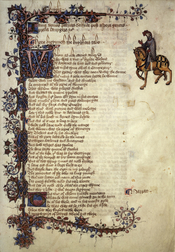Fin' amors means "fine love" or "refined love" and has had a profound influence on attitudes towards, and between, lovers and beloveds for centuries. Essentially it is the knightly, or noble, worship of an ideal woman, in which the act of loving is in itself ennobling and refining. The ideals of fin' amors arose in twelfth century France and spread throughout western and northern Europe and is very much associated with the Middle Ages, when romances of chivalry started to take the place of old heroic narratives. It is a major theme throughout medieval literature, which has sometimes been characterised as the 'Age of Romance', and it is a major Chaucerian theme. This essay will discuss Chaucer's treatment of fin' amors, particularly the tradition of the descriptio, with reference to three of his major work's: "The Book of the Duchess", "The Knight's Tale" and "The Miller's Tale".
Chaucer's "The Book of the Duchess" has influences from Guillaume Lorris's Roman de la Rose (which Chaucer had translated) in its presentation of the dream-vision, and also incorporates Ovid's Metamorphoses story of Seys and Alcyone. The convention of heroic love and traditions of fin' amors are also very evident in the story, it can even seem at times as if Chaucer goes out of his way to show his knowledge of the French tradition. The speaker's descriptions of the Knight and of his dress, manner, and speech are all directly associated with the fin' amors idea of lovesickness, indeed, the speaker mistakes the Knight's mourning of death for lovesickness from the beginning. The Knight is typically 'clothed al in black' [457] and is 'pitous pale' [470], he 'disputed faste / Why and how hys lyf might last' [505-6], and he did not/could not hear the narrator at his first...

![Image taken from page 80 of 'The Rhyme of the Duchess May. [From “Poems”] ... Illustrated by Charlotte M. B. Morrell'](https://s.writework.com/uploads/6/67341/image-taken-page-80-rhyme-duchess-may-poems-illustrated-char-thumb.jpg)
![Image taken from page 15 of 'The Rhyme of the Duchess May. [From “Poems”] ... Illustrated by Charlotte M. B. Morrell'](https://s.writework.com/uploads/6/67341/image-taken-page-15-rhyme-duchess-may-poems-illustrated-char-thumb.jpg)